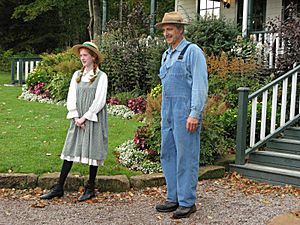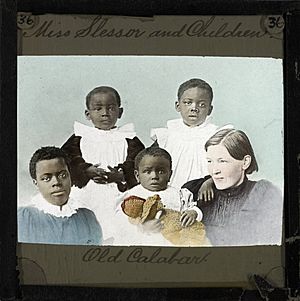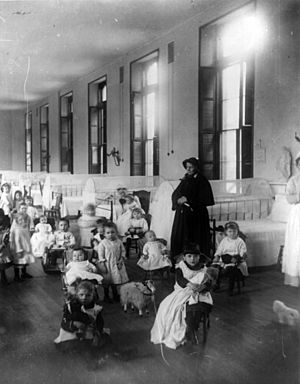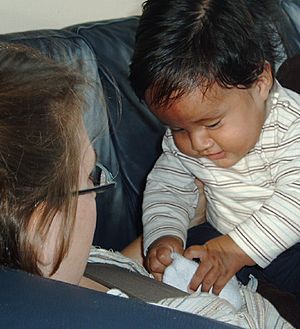Adoption facts for kids

Adoption is the legal act of permanently placing a child with a parent or parents other than the birth parents. Adoption usually results in the severing of the parental responsibilities and rights of the biological parents and the placing of those responsibilities and rights onto the adoptive parents. After the finalization of an adoption, there is no legal difference between biological and adopted children, although there is a world of difference outside of the legal world.
Different jurisdictions have varying laws on adoption and post-adoption. Some practise closed adoption, preventing further contact between the adopted person and the biological parents, while others have varying degrees of open adoption, which may allow such contact.
Joint adoption by same-sex couples is legal in 26 countries.
Contents
Reasons for adoption
Most children are placed for adoption as a result of the biological parents' decision that they are unable to adequately care for a child. Rarer are cases in which biological parents have lost their responsibilities and rights due to neglect or abuse. A small percentage of children who were adopted have been orphaned because of the death of their biological parents.
In some cases, parents' rights have been terminated when their outgroup culture has been deemed unfit by the controlling government. Aboriginal Peoples in Australia were affected by such policies, as were Native Americans in the United States and Canada.
Adoption Agencies
Adoption agencies can range from government-funded agencies that place children at little cost, to lawyers who arrange private adoptions, to international commercial and non-profit agencies. Adoptive parents can pay from nothing to US$20,000 for an adoption, with private adoptions generally costing more. Infants are more commonly sought than toddlers or older children, and adoptive parents often seek the same race.
How adoptions originate
Adoptions can occur either between related family members, or unrelated individuals. Historically, most adoptions occurred within a family. The most recent data from the U.S. indicates about half of adoptions are currently between related individuals. A common example of this is a "step-parent adoption", where the new partner of a parent may legally adopt a child from the parent's previous relationship.
Infertility is the main reason parents seek to adopt children they are not related to. One study shows this accounted for 80% of unrelated infant adoptions and half of adoptions through foster care. Estimates suggest that 11–24% of Americans who cannot conceive or carry to term attempt to build a family through adoption.
Other reasons people adopt are numerous , these may include wanting to cement a new family following divorce or death of one parent, compassion motivated by religious or philosophical conviction, to avoid contributing to overpopulation out of the belief that it is more responsible to care for otherwise parent-less children than to reproduce, to ensure that inheritable diseases are not passed on, and health concerns relating to pregnancy and childbirth.
Although there are a range of possible reasons, the most recent study of experiences of women who adopt suggests they are most likely to be 40–44 years of age, currently married, have impaired fertility, and childless.
Examples of adoption:
- Private domestic adoptions: under this arrangement, charities and for-profit organizations bring together prospective adoptive parents and families who want to place a child, all parties being residents of the same country. Private domestic adoption accounts for a significant portion of all adoptions; in the United States, for example, nearly 45% of adoptions are estimated to have been arranged privately.
- Foster care adoption: this is a type of domestic adoption where a child is initially placed in public care. Many times the foster parents take on the adoption when the children become legally free.
- International adoption: involves the placing of a child for adoption outside that child's country of birth. This can occur through both public and private agencies.
- Embryo adoption: based on the donation of embryos remaining after one couple's in vitro fertilization treatments have been completed; embryos are given to another individual or couple.
- Common law adoption: this is an adoption which has not been recognized by the courts, but where a parent, without any formal legal process, leaves the child with a friend or relative for an extended period of time.
Reunification
Many adopted people and biological parents who were separated by adoption have a natural desire to reunite. In countries which practise closed adoption, this desire has led to efforts to open sealed records and efforts to establish the right of those adopted to access their sealed records.
Related pages
Images for kids
-
At the monastery gate (Am Klostertor) by Ferdinand Georg Waldmüller
-
Josephine Baker adopted 10 children in the 1960s. In this photo they are on a tour of Amsterdam in 1964.
-
Children associated with'Hope and Homes for Children, a foster care program in Ukraine
See also
 In Spanish: Adopción para niños
In Spanish: Adopción para niños










